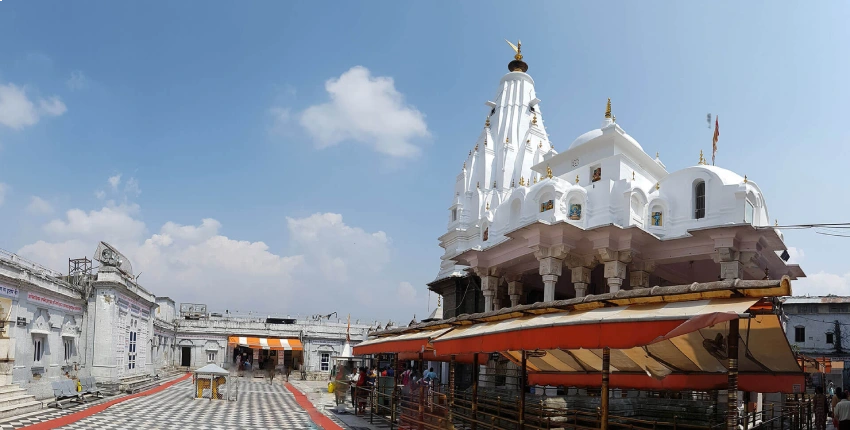Shakti Peeth in Himachal Pradesh: Sacred Temples of Divine Feminine Power

The Shakti Peeths are among the most revered shrines in Hinduism, symbolizing the divine feminine energy (Shakti) and rooted in ancient mythology. According to legend, these shrines emerged from the tragic tale of Goddess Sati, who self-immolated in protest of her father Daksha’s disrespect toward her husband, Lord Shiva. Overwhelmed by grief, Shiva carried her charred body across the cosmos, and as Lord Vishnu dismembered it to calm Shiva’s destructive Tandava dance, her body parts fell to Earth, each site becoming a Shakti Peeth.
Himachal Pradesh, nestled in the Himalayas, is not only a paradise for nature lovers but also a spiritual haven hosting several of these sacred shrines. Each temple here embodies unique legends, architectural marvels, and an aura of devotion. This blog explores the Shakti Peeths of Himachal, delving into their histories, significance, and the transformative experiences they offer pilgrims.
1. Naina Devi Temple: The Eyes of the Goddess
Location: Bilaspur District, on a Hilltop Overlooking Gobind Sagar Lake
Body Part: Eyes (Naina) of Sati
Legend & Significance:
Naina Devi Temple is believed to mark the spot where Goddess Sati’s eyes fell. The name “Naina” (eyes) reflects this lore. Another legend ties the temple to a blind devotee named Naina, whose sight was restored after she offered her eyes to the goddess.
Architecture & Ambiance:
Perched atop a hill, the temple offers panoramic views of the surrounding valleys and lake. The ascent involves climbing 1,300 steps or taking a cable car. The sanctum houses two large eyes symbolizing the goddess, flanked by idols of Lord Ganesha and Hanuman.
Festivals & Rituals:
Navratri sees throngs of devotees participating in jagrans (night vigils) and offering coconuts and sweets. The temple’s serene environment, especially during sunrise, enhances its spiritual vibe.
Travel Tips:
- Best Time to Visit: September–March, avoiding monsoon landslides.
- Nearby Attractions: Gobind Sagar Lake, Bhakra Dam.
2. Jwalamukhi Temple: The Eternal Flame of Divine Power
Location: Kangra District, 35 km from Dharamshala
Body Part: Tongue of Sati
Legend & Significance:
Jwalamukhi, meaning “volcanic mouth,” is unique for its natural blue flames emanating from rock crevices, symbolizing Sati’s tongue. Legend says a cowherd discovered the flames, and Emperor Akbar once tried extinguishing them, only to fail and become a devotee.
Architecture & Rituals:
Unlike traditional temples, Jwalamukhi has no idol. The flames, fed by natural gas, are central to worship. Priests perform aarti with a giant brass bell, creating a mesmerizing atmosphere.
Festivals:
Navratri and the annual “Jwalamukhi Fair” in October attract thousands. Devotees offer rabri (sweet porridge) believed to appease the fiery goddess.
Travel Tips:
- Combine With: Visit Kangra Fort and Masroor Rock Cut Temple.
- Stay: Dharamshala offers diverse accommodations.
3. Chintpurni Temple: The Liberator from Worries
Location: Una District, Amidst Scenic Hills
Body Part: Feet of Sati
Legend & Significance:
Chintpurni, derived from “Chinta” (worries) and “Purni” (reliever), is where Sati’s feet fell. A local tale tells of a devotee, Mai Das, who dreamt of the goddess guiding him to her idol under a tree, now the temple site.
Architecture & Practices:
The idol of Chinnamastika (self-decapitated goddess) is unique, symbolizing detachment from worldly desires. The temple’s simplicity contrasts with its powerful energy.
Festivals:
Sawan (July–August) and Navratri are peak times. Devotees tie sacred threads around a tree, praying for wishes to be granted.
Travel Tips:
- Nearby: Mata Talab Temple and Bharwain Market for handicrafts.
- Accessibility: Well-connected by road from Pathankot.
4. Brajeshwari Devi Temple (Kangra): The Abode of Cosmic Knowledge
Location: Kangra Town
Body Part: Breast (Sati’s left breast)
Legend & History:
Also known as Kangra Devi, this temple’s origins trace back to the Mahabharata era. It’s survived invasions, including Mahmud Ghazni’s raid in 1009 AD. The goddess is worshipped as Vajreshwari, embodying wisdom.
Architecture:
Rebuilt in the 20th century after earthquakes, the temple blends traditional Himachali and modern styles. Intricate carvings and a gold-plated spire stand out.
Cultural Impact:
The temple is a cultural hub during Durga Puja, with classical music and dance performances.
Travel Tips:
- Explore: Kangra Art Museum and nearby tea gardens.
5. Chamunda Devi Temple: The Slayer of Evil
Location: Palampur, Overlooking the Dhauladhar Range
Body Part: Not part of Sati’s body but a revered Shakti site
Legend:
Chamunda, a form of Kali, slew demons Chanda and Munda here. The temple’s 400-year-old idol, discovered by a king during a hunt, radiates fierce energy.
Ambiance & Rituals:
Surrounded by forests, the temple offers tranquility. Animal sacrifices, once common, are now replaced with symbolic offerings.
Festivals:
Navratri features vibrant processions. The nearby Ban Ganga River is considered sacred.
Travel Tips:
- Combine With: Visit Andretta Pottery Village and Bir-Billing for paragliding.
Pilgrimage Essentials: Planning Your Visit
- Best Season: April–June and September–October for pleasant weather.
- Transport: Major temples are accessible via road from cities like Chandigarh and Pathankot.
- Accommodation: Ranges from budget dharamshalas to luxury resorts.
- Local Cuisine: Try Himachali dishes like Siddu and Dham.
Conclusion: The Eternal Call of the Goddess
The Shakti Peeths of Himachal Pradesh are not just religious sites but portals to India’s spiritual heritage. Each temple, with its distinct narrative and energy, invites devotees to seek blessings and inner peace. Whether drawn by faith or curiosity, a journey to these sacred shrines promises a transformative experience, set against the breathtaking backdrop of the Himalayas.
Embark on this pilgrimage to connect with the divine feminine, immerse in ancient rituals, and discover the timeless allure of Himachal’s Shakti Peeths.



